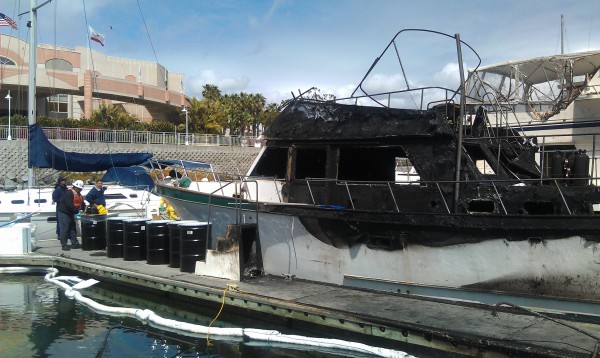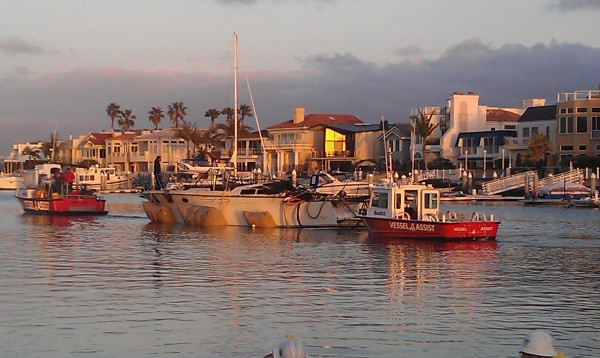TowBoatUS San Diego Salvages Two Boats After Fire Rips Through Them
Once again faulty wiring looks to be the cause of another boat fire. This one was at the Lowes Coronado Marina. A 55’Cabin Cruiser and a 45’ Trawler were burned beyond repair Thursday night. Vessel Assist San Diego deployed an 8 man crew with two boats and two truckloads of equipment, to secure and remove the first boat, a 45’ Trawler. The second boat, a 55’ Cruiser was sunk after it burned to the decks. The night before, Coronado Fire Department responded in full force, keeping water on the fire from land. The new, million dollar San Diego Harbor fire/police boat, was put into real action and performed as expected. The new 32’ Metal Craft and and its well-trained crew, used its high powered water cannons to attack the fire and keep it from destroying other boats. As with most boat fires the amount of water used to put the fire out usually is more than the buoyancy of the boat can handle. The 55’ boat sank in its slip. NRC environmental came to the aid for the huge environmental spill after a reported 500 gallons of diesel fuel, debris, and ash polluted the water. NRC used several trailers full of oil containment boom and sorbent sweeps and pads to contain and clean up the spill. Vessel Assist San Diego and its salvage team arrived after the USCG completed its initial investigation. Captain Shane Thompson and Salvage Diver Augustine Malfavon had the dangerous task of diving in floating fuel and fire debris. The first task for the Salvage crew was to secure the badly burned 45’ Trawler and tow it for an emergency haul out. One major issue was 5 SCUBA tanks full of air were aboard the vessel and the J-valves were burned to a point of failure. This created a very dangerous situation. Coronado Fire Came to the rescue and in their highly skilled response discharged the SCUBA tanks. Next float bags were attached to the boat to stabilize her as the amount of water in the boat used to extinguish the fire threatened the stability of the vessel. The side of the boat was burned as were all of the thru hull fittings. Special putty was placed where water was entering the vessel. Because the water inside the vessel was contaminated, pumping the boat free of water before moving her was not an option. Captain Greg Rood and his deck hand, Garrett Malfavon, slowly and carefully towed the burned vessel to Marine Group Boat Works, for emergency haul out. The second vessel was much tougher, after it sank, it drifted under the finger of the dock. A special lift technique was used to get the boat to the surface and out from under the docks. Captain Tony Olson and Salvage Specialist Tom Butler set up float bags for the divers to place in the charred vessel. Once the vessel was off the bottom Salvage Master and Captain Rob Butler directed the crew and divers and in a combined effort slowly moved the large hull out of the slip. Once secured, 50,000 pounds of additional, float bags were placed in the vessel using belly band lines going all around the boat to lift it high enough to pump the water out of the boat. “Usually we can tie to cleats and other areas of a boat with our lift bags, but, this boat was structurally unstable to use standard methods. Belly bands effectevley uses the lift of one float bag to counter the lift of another equal bag on the other side of the boat.” Captain Butler stated. After several hours of maneuvering float bags the vessel was pumped out until Captain Rob Butler decided the vessel was seaworthy enough for the slow tow to Marine Group Boat Works. Captain Butler knew they were on borrowed time and the stress of just lifting the hull from the bottom was enough to break it apart. Captain Tony Olson aboard the Salvage Vessel “Shelter Island” took the boat in tow on a short string (about 25’ tow line) this enables the 900 hp twin screw tow boat to maneuver through the tight waterway and across the bay, yet left it close enough to keep adding air to the attached float bags. Captain Greg Rood aboard the Salvage Vessel “Lajolla” with Salvage divers Shane Thompson and Augustine Malfavon aboard the burned wreck monitored the water still entering the vessel and controlled the damage until it could be hauled out of the water. Once the burned vessel was in the grasp of the giant sling straps of the travel lift the inevitable happened. The boat started to tear in half. NRC environmental responded with additional boom and a Giant Vacuum truck. 3000 gallons of contaminated water were removed by the truck and the boat, over 20,000 lbs. lighter, was removed from the water. NRC teamed up with the Vessel Assist San Diego Salvage Crew to remove the remaining 3000 gallons of fuel and contaminated water from both the boats the next morning. I appeared a short circuit in the 220 volt shore power cord may have been the source of the fire. The owners were on board when the fire started but escaped injury.
The first task for the Salvage crew was to secure the badly burned 45’ Trawler and tow it for an emergency haul out. One major issue was 5 SCUBA tanks full of air were aboard the vessel and the J-valves were burned to a point of failure. This created a very dangerous situation. Coronado Fire Came to the rescue and in their highly skilled response discharged the SCUBA tanks. Next float bags were attached to the boat to stabilize her as the amount of water in the boat used to extinguish the fire threatened the stability of the vessel. The side of the boat was burned as were all of the thru hull fittings. Special putty was placed where water was entering the vessel. Because the water inside the vessel was contaminated, pumping the boat free of water before moving her was not an option. Captain Greg Rood and his deck hand, Garrett Malfavon, slowly and carefully towed the burned vessel to Marine Group Boat Works, for emergency haul out. The second vessel was much tougher, after it sank, it drifted under the finger of the dock. A special lift technique was used to get the boat to the surface and out from under the docks. Captain Tony Olson and Salvage Specialist Tom Butler set up float bags for the divers to place in the charred vessel. Once the vessel was off the bottom Salvage Master and Captain Rob Butler directed the crew and divers and in a combined effort slowly moved the large hull out of the slip. Once secured, 50,000 pounds of additional, float bags were placed in the vessel using belly band lines going all around the boat to lift it high enough to pump the water out of the boat. “Usually we can tie to cleats and other areas of a boat with our lift bags, but, this boat was structurally unstable to use standard methods. Belly bands effectevley uses the lift of one float bag to counter the lift of another equal bag on the other side of the boat.” Captain Butler stated. After several hours of maneuvering float bags the vessel was pumped out until Captain Rob Butler decided the vessel was seaworthy enough for the slow tow to Marine Group Boat Works. Captain Butler knew they were on borrowed time and the stress of just lifting the hull from the bottom was enough to break it apart. Captain Tony Olson aboard the Salvage Vessel “Shelter Island” took the boat in tow on a short string (about 25’ tow line) this enables the 900 hp twin screw tow boat to maneuver through the tight waterway and across the bay, yet left it close enough to keep adding air to the attached float bags. Captain Greg Rood aboard the Salvage Vessel “Lajolla” with Salvage divers Shane Thompson and Augustine Malfavon aboard the burned wreck monitored the water still entering the vessel and controlled the damage until it could be hauled out of the water. Once the burned vessel was in the grasp of the giant sling straps of the travel lift the inevitable happened. The boat started to tear in half. NRC environmental responded with additional boom and a Giant Vacuum truck. 3000 gallons of contaminated water were removed by the truck and the boat, over 20,000 lbs. lighter, was removed from the water. NRC teamed up with the Vessel Assist San Diego Salvage Crew to remove the remaining 3000 gallons of fuel and contaminated water from both the boats the next morning. I appeared a short circuit in the 220 volt shore power cord may have been the source of the fire. The owners were on board when the fire started but escaped injury.

